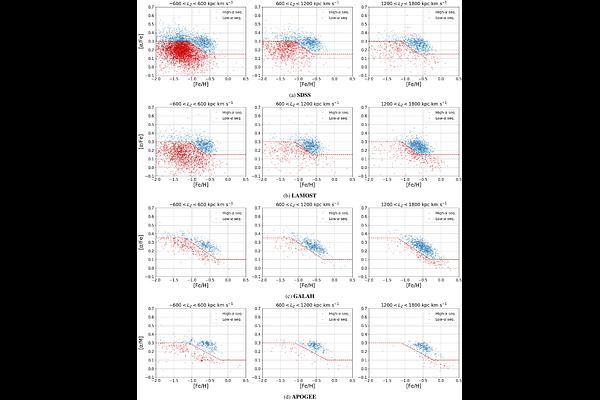Deciphering the Milky Way's Star Formation at Cosmic Noon with High Proper-Motion Stars: A Precursor to the Merger-Driven Starburst

Deciphering the Milky Way's Star Formation at Cosmic Noon with High Proper-Motion Stars: A Precursor to the Merger-Driven Starburst
Deokkeun An, Young Sun Lee, Yutaka Hirai, Timothy C. Beers
AbstractEvidence suggests that the Milky Way (MW) underwent a major collision with the Gaia-Sausage/Enceladus (GSE) dwarf galaxy around cosmic noon. While GSE has since been fully disrupted, it brought in ex-situ stars and dynamically heated in-situ stars into the halo. In addition, the gas-rich merger may have triggered a burst of in-situ star formation, potentially giving rise to a chemically distinct stellar component. We investigate the region of phase space where stars formed during the GSE merger likely reside, and retain distinct chemical and dynamical signatures. Building on our previous investigation of metallicity ([Fe/H]) and vertical angular momentum ($L_Z$) distributions, we analyse spectroscopic samples from GALAH, APOGEE, SDSS, and LAMOST, combined with Gaia kinematics. We focus on high proper-motion stars as effective tracers of the phase-space volume likely influenced by the GSE merger. To correct for selection effects, we incorporate metallicity estimates derived from SDSS and SMSS photometry. Our analysis reveals that low-$\alpha$ stars with GSE-like kinematics exhibit bimodality in [Na/Fe] and [Al/Fe] at $-1.0 \lesssim {\rm [Fe/H]} \lesssim -0.4$. One group follows the low light-element abundances of GSE stars, while another exhibits enhanced values. These low-$\alpha$, high-Na stars have eccentric orbits, but are more confined to the inner MW. A subset of these stars overlaps with the Eos population, representing only the high-eccentricity portion of a broader structure. After correcting for sampling biases, we find that the population comprises $\sim7\%$ relative to the GSE debris. These results suggest that the low-$\alpha$, high-Na stars formed in a compact region, likely fueled by gas from the GSE progenitor, analogous to clumpy star-forming clouds seen in high-redshift galaxies. Such stars may trace the first sparks of more extensive merger-driven starburst activity.